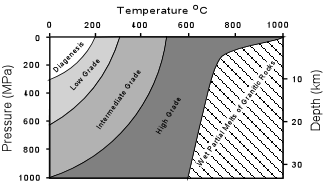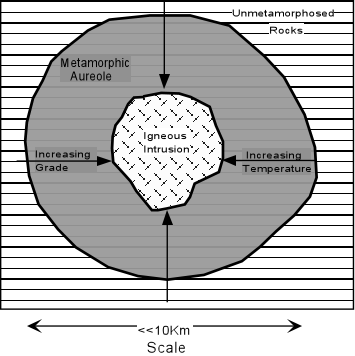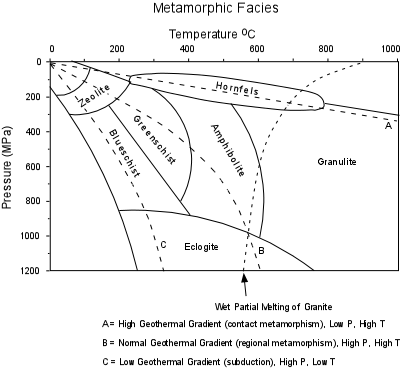|
Texture
In metamorphic rocks individual minerals may or may not be bounded by crystal faces. Those
that are bounded by their own crystal faces are termed idioblastic.
Those that show none of their own crystal faces are termed xenoblastic.
From examination of metamorphic rocks, it has been found that metamorphic minerals can be
listed in a generalized sequence, known as the crystalloblastic series,
listing minerals in order of their tendency to be idioblastic. In the series, each mineral
tends to develop idioblastic surfaces against any mineral that occurs lower in the series.
This series is listed below:
- rutile, sphene, magnetite
- tourmaline kyanite, staurolite, garnet, andalusite
- epidote, zoisite, lawsonite, forsterite
- pyroxenes, amphiboles, wollastonite
- micas, chlorites, talc, stilpnomelane, prehnite
- dolomite, calcite
- scapolite, cordierite, feldspars
- quartz
This series can, in a rather general way, enable us to determine the origin of a given
rock. For example a rock that shows euhedral plagioclase crystals in contact with anhedral
amphibole, likely had an igneous protolith, since a metamorphic rock with the same
minerals would be expected to show euhedral amphibole in contact with anhedral
plagioclase.
Another aspect of the crystalloblastic series is that minerals high on the list tend to
form porphyroblasts (the metamorphic equivalent of phenocrysts),
although K-feldspar (a mineral that occurs lower in the list) may also form
porphyroblasts. Porphyroblasts are often riddled with inclusions of other minerals that
were enveloped during growth of the porphyroblast. These are said to have a poikioblastic
texture.
Most metamorphic textures involve foliation. Foliation is generally caused by a
preferred orientation of sheet silicates. If a rock has a slatey cleavage as its
foliation, it is termed a slate, if it has a
phyllitic foliation,
it is termed a phyllite, if it has a shistose foliation, it is
termed a schist. A rock that shows a banded texture without a
distinct foliation is termed a gneiss. All of these could be
porphyroblastic (i.e. could contain porhyroblasts).
A rock that shows no foliation is called a hornfels if the
grain size is small, and a granulite, if the grain size is large
and individual minerals can be easily distinguished with a hand lens.
Protolith
Protolith refers to the original rock, prior to metamorphism. In low grade
metamorphic rocks, original textures are often preserved allowing one to
determine the likely protolith. As the grade of metamorphism increases, original
textures are replaced with metamorphic textures and other clues, such as bulk chemical
composition of the rock, are used to determine the protolith.
Bulk Chemical Composition
The mineral assemblage that develops in a metamorphic rock is dependent on
- The pressure and temperature reached during metamorphism
The composition of any fluid phase present during metamorphism, and
The bulk chemical composition of the rock.
Just like in igneous rocks, minerals can only form if the
necessary chemical constituents are present in the rock (i.e. the concept of silica
saturation and alumina saturation applies to metamorphic rocks as well). Based on
the mineral assemblage present in the rock one can often estimate the approximate bulk
chemical composition of the rock. Some terms that describe this general bulk
chemical composition are as follows:
- Pelitic. These rocks are derivatives of aluminous
sedimentary rocks like shales and mudrocks. Because of their high concentrations of
alumina they are recognized by an abundance of aluminous minerals, like clay minerals,
micas, kyanite, sillimanite, andalusite, and garnet.
- Quartzo-Feldspathic. Rocks that originally contained
mostly quartz and feldspar like granitic rocks and arkosic sandstones will also contain an
abundance of quartz and feldspar as metamorphic rocks, since these minerals are stable
over a wide range of temperature and pressure. Those that exhibit mostly quartz and
feldspar with only minor amounts of aluminous minerals are termed quartzo-feldspathic.
- Calcareous. Calcareous rocks are calcium rich.
They are usually derivatives of carbonate rocks, although they contain other minerals that
result from reaction of the carbonates with associated siliceous detrital minerals that
were present in the rock. At low grades of metamorphism calcareous rocks are
recognized by their abundance of carbonate minerals like calcite and dolomite. With
increasing grade of metamorphism these are replaced by minerals like brucite, phlogopite
(Mg-rich biotite), chlorite, and tremolite. At even higher grades anhydrous minerals
like diopside, forsterite, wollastonite, grossularite, and calcic plagioclase.
- Basic. Just like in igneous rocks, the general term
basic refers to low silica content. Basic metamorphic rocks are generally
derivatives of basic igneous rocks like basalts and gabbros. They have an abundance
of Fe-Mg minerals like biotite, chlorite, and hornblende, as well as calcic minerals like
plagioclase and epidote.
- Magnesian. Rocks that are rich in Mg with relatively less Fe,
are termed magnesian. Such rocks would contain Mg-rich minerals like serpentine,
brucite, talc, dolomite, and tremolite. In general, such rocks usually have an
ultrabasic protolith, like peridotite, dunite, or pyroxenite.
- Ferriginous. Rocks that are rich in Fe with little Mg are
termed ferriginous. Such rocks could be derivatives of Fe-rich cherts or ironstones.
They are characterized by an abundance of Fe-rich minerals like greenalite
(Fe-rich serpentine), minnesotaite (Fe-rich talc), ferroactinolite, ferrocummingtonite,
hematite, and magnetite at low grades, and ferrosilite, fayalite, ferrohedenbergite, and
almandine garnet at higher grades.
- Manganiferrous. Rocks that are characterized by the presence
of Mn-rich minerals are termed manganiferrous. They are characterized by such
minerals as Stilpnomelane and spessartine.
Classification
Classification of metamorphic rocks depends on what is visible in the rock and its degree
of metamorphism. Note that classification is generally loose and practical such that names
can be adapted to describe the rock in the most satisfactory way that conveys the
important characteristics. Three kinds of criteria are normally employed. These are:
- Mineralogical - The most distinguishing minerals are used as a prefix to a textural
term. Thus, a schist containing biotite, garnet, quartz, and feldspar, would be called a
biotite-garnet schist. A gneiss containing hornblende, pyroxene, quartz, and feldspar
would be called a hornblende-pyroxene gneiss. A schist containing porphyroblasts of
K-feldspar would be called a K-spar porphyroblastic schist.
- Chemical - If the general chemical composition can be determined from the mineral
assemblage, then a chemical name can be employed. For example a schist with a lot of
quartz and feldspar and some garnet and muscovite would be called a garnet-muscovite
quartzo-feldspathic schist. A schist consisting mostly of talc would be called a
talc-magnesian schist.
Protolithic - If a rock has undergone only slight metamorphism such that its
original texture can still be observed then the rock is given a name based on its original
name, with the prefix meta- applied. For example: metabasalt, metagraywacke,
meta-andesite,
metagranite.
In addition to these conventions, certain non-foliated rocks with specific chemical
compositions and/or mineral assemblages are given specific names. These are as follows:
- Amphibolites: These are medium to coarse grained, dark colored
rocks whose principal minerals are hornblende and plagioclase. They result from
metamorphism of basic igneous rocks. Foliation is highly variable, but when present
the term schist can be appended to the name (i.e. amphibolite schist).
Marbles: These are rocks composed mostly
of calcite, and less commonly of dolomite. They result from metamorphism of limestones and
dolostones. Some foliation may be present if the marble contains micas.
Eclogites: These are medium to coarse
grained consisting mostly of garnet and green clinopyroxene called omphacite, that result
from high grade metamorphism of basic igneous rocks. Eclogites usually do not show
foliation.
Quartzites: Quartz arenites and chert
both are composed mostly of SiO2. Since quartz is stable over a wide range of
pressures and temperatures, metamorphism of quartz arenites and cherts will result only in
the recrystallization of quartz forming a hard rock with interlocking crystals of quartz.
Such a rock is called a quartzite.
Serpentinites: Serpentinites are
rocks that consist mostly of serpentine. These form by hydrothermal metamorphism of
ultrabasic igneous rocks.
Soapstones: Soapstones are rocks that
contain an abundance of talc, which gives the rock a greasy feel, similar to that of soap.
Talc is an Mg-rich mineral, and thus soapstones from ultrabasic igneous
protoliths, like peridotites, dunites, and pyroxenites, usually by
hydrothermal alteration.
Skarns: Skarns are rocks that originate
from contact metamorphism of limestones or dolostones, and show evidence of having
exchanged constituents with the intruding magma. Thus, skarns are generally composed
of minerals like calcite and dolomite, from the original carbonate rock, but contain
abundant calcium and magnesium silicate minerals like andradite, grossularite, epidote,
vesuvianite, diopside, and wollastonite that form by reaction of the original carbonate
minerals with silica from the magma. The chemical exchange is that takes place
is called metasomatism.
Mylonites: Mylonites are cataclastic
metamorphic rocks that are produced along shear zones deep in the crust. They are
usually fine-grained, sometimes glassy, that are streaky or layered, with the layers and
streaks having been drawn out by ductile shear.
|


